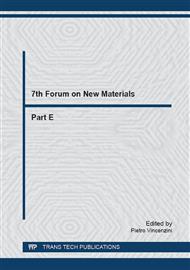[1]
Odgaard, P.; Johnson, K. Wind Turbine Fault Diagnosis and Fault Tolerant Control-An Enhanced Benchmark Challenge. In Proceedings of the 2013 American Control Conference (ACC), Washington, DC, USA, 17-19 June 2013; pp.1-6.
DOI: 10.1109/acc.2013.6580525
Google Scholar
[2]
Soman, R.N.; Malinowski, P.H.; Ostachowicz, W.M. Bi-axial neutral axis tracking for damage detection in wind-turbine towers. Wind Energy 2015, doi: 10. 1002/we. 1856.
DOI: 10.1002/we.1856
Google Scholar
[3]
Griffith, D.T.; Yoder, N.C.; Resor, B.; White, J.; Paquette, J. Structural health and prognostics management for the enhancement of offshore wind turbine operations and maintenance strategies. Wind Energy 2014, 17, 1737-1751.
DOI: 10.1002/we.1665
Google Scholar
[4]
Ding, S.X. Model-Based Fault Diagnosis Techniques: Design Schemes, Algorithms, and Tools; Springer Science & Business Media: London, UK, (2008).
Google Scholar
[5]
Shi, F.; Patton, R. An active fault tolerant control approach to an offshore wind turbine model. Renew. Energy 2015, 75, 788-798.
DOI: 10.1016/j.renene.2014.10.061
Google Scholar
[6]
Vidal, Y.; Tutiven, C.; Rodellar, J.; Acho, L. Fault Diagnosis and Fault-Tolerant Control of Wind Turbines via a Discrete Time Controller with a Disturbance Compensator. Energies 2015, 8, 4300-4316.
DOI: 10.3390/en8054300
Google Scholar
[7]
Dong, J.; Verhaegen, M. Data driven fault detection and isolation of a wind turbine benchmark. In Proceedings of the International Federation of Automatic Control (IFAC) World Congress, Milano, Italy, 28 August-2 September 2011; Volume 2, pp.7086-7091.
DOI: 10.3182/20110828-6-it-1002.00546
Google Scholar
[8]
Kusiak, A.; Li, W.; Song, Z. Dynamic control of wind turbines. Renew. Energy 2010, 35, 456- 463.
DOI: 10.1016/j.renene.2009.05.022
Google Scholar
[9]
Jonkman, J. NWTC Information Portal (FAST). https: /nwtc. nrel. gov/FAST. Last modified 19- March-2015; Accessed 18-December-(2015).
Google Scholar
[10]
Jonkman, J.M.; Butterfield, S.; Musial, W.; Scott, G. Definition of a 5-MW Reference Wind Turbine for Offshore System Development. National Renewable Energy Laboratory, Golden, CO, USA, (2009).
DOI: 10.2172/947422
Google Scholar
[11]
Anaya, M.; Tibaduiza, D.; Pozo, F. A bioinspired methodology based on an artificial immune system for damage detection in structural health monitoring. Shock Vibration 2015, 2015, 1-15.
DOI: 10.1155/2015/648097
Google Scholar
[12]
Anaya, M.; Tibaduiza, D.; Pozo, F. Detection and classification of structural changes using artificial immune systems and fuzzy clustering. Int. J. Bio-Inspired Comput., in press.
DOI: 10.1504/ijbic.2017.10002804
Google Scholar
[13]
Mujica, L.E.; Ruiz, M.; Pozo, F.; Rodellar, J.; Güemes, A. A structural damage detection indicator based on principal component analysis and statistical hypothesis testing. Smart Mater. Struct. 2014, 23, 1-12.
DOI: 10.1088/0964-1726/23/2/025014
Google Scholar
[14]
Mujica, L.E.; Rodellar, J.; Fernández, A.; Güemes, A. Q-statistic and T2-statistic PCA-based measures for damage assessment in structures. Struct. Health Monit. 2011, 10, 539-553.
DOI: 10.1177/1475921710388972
Google Scholar
[15]
Odgaard, P.F.; Lin, B.; Jorgensen, S.B. Observer and data-driven-model-based fault detection in power plant coal mills. IEEE Trans. Energy Convers. 2008, 23, 659-668.
DOI: 10.1109/tec.2007.914185
Google Scholar
[16]
Ugarte, M.D.; Militino, A.F.; Arnholt, A. Probability and Statistics with R; CRC Press (Taylor & Francis Group): Boca Raton, FL, USA, (2008).
Google Scholar


